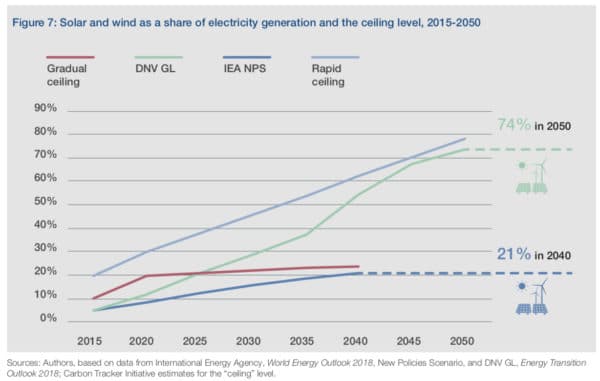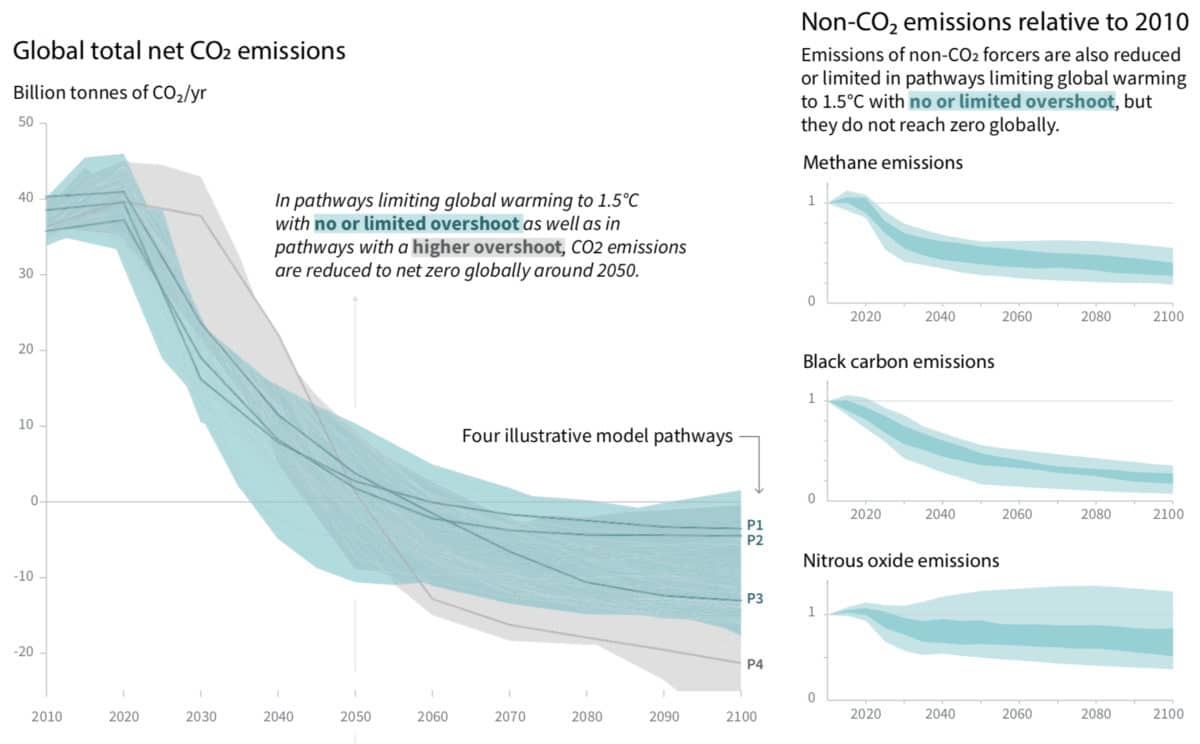A World Economic Forum paper has quietly asked all of us to notice how we think and talk about the renewables transition.
Do we describe a “rapid narrative,” where the amount of renewables deployed continues to increase 15-30% each year? Or do we promote a “gradual narrative,” projecting that renewables deployment remains much the same each year for decades, while fossil fuel continues to power the world?
Either narrative “can become self-fulfilling,” says the World Economic Forum (WEF) report The Speed of the Energy Transition. That’s because narratives, or expectations, drive investments, policy, and progress, says the report, citing research by a UK climate commission. The theme of a self-fulfilling narrative echoes an old saying, suggesting that whether we think we can achieve a rapid renewables transition, or think we can’t, we’re right.
The two narratives are in effect competing over how soon a tipping point is reached. “Once a tipping point is reached, financial markets will tend to speed up the pace of change by constraining capital to declining industries and reallocating it to those that are growing,” says the WEF report, citing a study for the UK’s Committee on Climate Change. The study’s author, Paul Ekins, elaborates:
“Once a technology becomes sufficiently competitive, it starts to change the entire environment in which it operates and interacts. New supply lines are formed, behaviors change, and new business lobbies push for more supportive policies. New institutions are created, and old ones repurposed. As costs fall and expectations of market size increase, additional investment is induced and the political and commercial barriers to a transition begin to drop away. A tipping point is eventually reached where incumbent technologies, products and networks become redundant.”
This all matters because the energy transition “is happening fast but not quickly enough,” said Ditlev Engel, CEO of consultancy DNV GL, in a foreword to the firm’s latest Power Supply and Use Forecast to 2050. (The WEF report highlights DNV GL’s forecasts as an example of the “rapid narrative.”)
Yet while DNV GL maintains a “checklist” for the next decade that includes installed PV increasing 10-fold globally to 5 terawatts (TW), and wind power increasing 5-fold to 3 TW, the firm projects that “CO2 emissions will not fall sufficiently by mid-century: the 2°C carbon budget will be exhausted in 2049.” Looking ahead just nine years, the 1.5°C carbon budget “will be exhausted as early as 2028.”
How rapid is rapid?
DNV GL’s checklist item of 5 TW of PV globally by 2030 represents a 20% compound annual growth rate (CAGR) in installations from 2018 to 2030.
In a more ambitious approach, 45 scientists and PV industry leaders envision a 30% CAGR in PV deployments through 2030, maintaining the 30% CAGR observed from 2008 to 2018. The top-notch journal Science published their peer-reviewed article “Terawatt-scale photovoltaics: Transform global energy” (free to access). At the 30% rate, PV installed globally would reach 10 TW by 2030, or double the amount in DNV GL’s checklist—and we would enter 2030 with a much larger PV manufacturing capacity as well.
The Solar Energy Industry Association (SEIA) aims to achieve nearly 400 GW of new solar in the U.S. by 2030, according to a LinkedIn post by the organization. That corresponds to a 16% CAGR, starting from 10.6 GW installed in the U.S. last year.
Curiously, even though DNV GL says its forecast through 2050 would not meet the Paris Agreement goal, the WEF report characterizes as a “rapid ceiling” a renewables growth rate that is barely above DNV GL’s forecast:

Distinctly in the “gradual narrative” camp is the International Energy Agency’s New Policies Scenario (“IEA NPS” in the graph above), which projects anemic growth in renewable generation. Other gradual scenarios, says the WEF report, are published by Exxon, the Organization of the Petroleum Exporting Countries (OPEC), the World Energy Council and the U.S. Energy Information Administration.
Favorite talking points of fossil fuel interests and other “gradual narrative” proponents are catalogued and challenged in the WEF report. The report also presents the case for the rapid narrative.
Rapid scenarios, says the report, include the primary scenarios of Bloomberg New Energy Finance, DNV GL, and McKinsey, along with the IEA Sustainable Development Scenario, the International Renewable Energy Agency (IRENA) REMap, and the Intergovernmental Panel on Climate Change (IPCC) “less than two-degree” models.
The tipping point
Any rapid renewables path will involve exponential growth, as Rocky Mountain Institute (RMI) CEO Jules Kortenhorst, one of three co-authors of the WEF report, described in a separate introduction:
“From the perspective of RMI, the evidence clearly points to a rapid energy transition scenario. A rapid transition means that renewables like wind and solar quickly start to supplant fossil fuels as their supply increases at an exponential rate, following the familiar S-curve growth pattern of new technologies like personal computers and mobile phones. It means … demand for fossil fuels peaking in the 2020s —and thus seriously disrupting the traditional businesses of the energy sector incumbents.”
DNV GL’s latest forecast has predicted those demand peaks: “We predict peak oil in 2022, with gas to follow in 2033. Coal has already peaked.” If the WEF report is correct, as each fossil fuel reaches peak consumption levels, investment in each sector will drop off, to be redirected to renewables.
Co-authors of the WEF report were Mr. Kortenhorst, Carbon Tracker Energy Strategist Kingsmill Bond, and Bloomberg New Energy Finance Chief Editor Angus McCrone.
This content is protected by copyright and may not be reused. If you want to cooperate with us and would like to reuse some of our content, please contact: editors@pv-magazine.com.








No, talking of faster adoption won’t lead to faster inveatment and adoption any more than will talking faster.
The confluence of technological improvements and relative costs and efficiency of alternatives will move adoption along.
Much of the needed infrastructure is in a sort of ‘just imagine’ stage – the PV cells are ready but the panel systems are still somewhat ugly and the storage syatems are too few and too expensive.
The inverters still don’t communicate and co-operate with each other, the grid, home hvac systems, and EV chargers. Two way chargers are still at the experimental stage. There is much work to be done before we know what to get behind and ‘talk up’ / push, let alone in exactly what direction.
“As for the future, it is not a question of predicting it, but of making it possible”: Antoine de Saint Exupery
We are well past the “Tipping Point” now — PV is already the lowest cost raw power (DOE SunShot!) and still going down another 50% (DOE SunShot2030). Li-ion batteries cost is falling like microprocessors were in 1975, and that created the whole new Information Age of mankind! The RE Revolution is happening WAY faster than any of the forecasters understand.
Maybe just “thinking” different will bring little change, but positive and aggressive Leadership can absolutely make it happen faster. And if you don’t believe in power of good Leadership, just look at Greta Thunberg — one young enthusiastic Leader and the world wakes up!